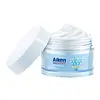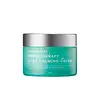What's inside
What's inside
 Key Ingredients
Key Ingredients

 Benefits
Benefits

 Ingredients Side-by-side
Ingredients Side-by-side

Water
Skin ConditioningNiacinamide
SmoothingGlycerin
HumectantBetaine
HumectantButylene Glycol
HumectantBiosaccharide Gum-1
HumectantDimethicone
EmollientCyclopentasiloxane
EmollientCarbomer
Emulsion StabilisingCyclohexasiloxane
EmollientBisabolol
MaskingAminomethyl Propanol
BufferingSodium Polyacrylate
AbsorbentXanthan Gum
EmulsifyingDisodium EDTA
Sodium Hyaluronate
HumectantDiethylhexyl Syringylidenemalonate
Skin ProtectingTrideceth-6
EmulsifyingPEG/PPG-18/18 Dimethicone
EmulsifyingAlpha-Glucan Oligosaccharide
CleansingCaprylic/Capric Triglyceride
MaskingPolymnia Sonchifolia Root Juice
Skin ConditioningMaltodextrin
AbsorbentAspergillus Ferment
Skin ConditioningZingiber Officinale Root Extract
MaskingLactobacillus
Skin ConditioningPhenoxyethanol
PreservativeChlorphenesin
AntimicrobialWater, Niacinamide, Glycerin, Betaine, Butylene Glycol, Biosaccharide Gum-1, Dimethicone, Cyclopentasiloxane, Carbomer, Cyclohexasiloxane, Bisabolol, Aminomethyl Propanol, Sodium Polyacrylate, Xanthan Gum, Disodium EDTA, Sodium Hyaluronate, Diethylhexyl Syringylidenemalonate, Trideceth-6, PEG/PPG-18/18 Dimethicone, Alpha-Glucan Oligosaccharide, Caprylic/Capric Triglyceride, Polymnia Sonchifolia Root Juice, Maltodextrin, Aspergillus Ferment, Zingiber Officinale Root Extract, Lactobacillus, Phenoxyethanol, Chlorphenesin
Water
Skin ConditioningCyclopentasiloxane
EmollientButylene Glycol
HumectantGlycerin
HumectantCyclohexasiloxane
EmollientNiacinamide
Smoothing1,2-Hexanediol
Skin ConditioningChamaecyparis Obtusa Water
MaskingHydroxyacetophenone
AntioxidantAmmonium Acryloyldimethyltaurate/Vp Copolymer
Dimethicone
EmollientCaprylyl Glycol
EmollientPolyacrylate-13
Carbomer
Emulsion StabilisingArginine
MaskingPolyisobutene
Panthenol
Skin ConditioningXanthan Gum
EmulsifyingAllantoin
Skin ConditioningEthylhexylglycerin
Skin ConditioningAdenosine
Skin ConditioningCitrus Aurantium Bergamia Fruit Oil
MaskingDisodium EDTA
Polysorbate 20
EmulsifyingSorbitan Isostearate
EmulsifyingDipropylene Glycol
HumectantSodium Hyaluronate
HumectantAloe Barbadensis Leaf Extract
EmollientPortulaca Oleracea Extract
Skin ConditioningMelia Azadirachta Leaf Extract
Skin ConditioningCentella Asiatica Extract
CleansingOcimum Sanctum Leaf Extract
Skin ConditioningAmber Powder
Corallina Officinalis Extract
Skin ConditioningMelia Azadirachta Flower Extract
Skin ConditioningCurcuma Longa Root Extract
MaskingCoccinia Indica Fruit Extract
Skin ConditioningMoringa Oleifera Seed Oil
EmollientSolanum Melongena Fruit Extract
Skin ConditioningErythritol
HumectantBisabolol
MaskingMadecassoside
AntioxidantPolyquaternium-51
Skin ConditioningMelaleuca Alternifolia Leaf Extract
PerfumingHouttuynia Cordata Extract
Skin ConditioningAsiaticoside
AntioxidantHizikia Fusiforme Extract
Skin ConditioningChlorella Vulgaris Extract
Skin ConditioningCodium Fragile Extract
Skin ConditioningUlva Lactuca Extract
Skin ConditioningMacrocystis Pyrifera Extract
Skin ConditioningFucus Vesiculosus Extract
EmollientLaminaria Cloustoni Extract
Skin ProtectingLaminaria Japonica Extract
Skin ProtectingGelidium Cartilagineum Extract
Skin ProtectingSalix Alba Bark Extract
AstringentPentylene Glycol
Skin ConditioningMentha Piperita Leaf Extract
Skin ConditioningMentha Suaveolens Leaf Extract
AstringentMentha Viridis Leaf Extract
MaskingWater, Cyclopentasiloxane, Butylene Glycol, Glycerin, Cyclohexasiloxane, Niacinamide, 1,2-Hexanediol, Chamaecyparis Obtusa Water, Hydroxyacetophenone, Ammonium Acryloyldimethyltaurate/Vp Copolymer, Dimethicone, Caprylyl Glycol, Polyacrylate-13, Carbomer, Arginine, Polyisobutene, Panthenol, Xanthan Gum, Allantoin, Ethylhexylglycerin, Adenosine, Citrus Aurantium Bergamia Fruit Oil, Disodium EDTA, Polysorbate 20, Sorbitan Isostearate, Dipropylene Glycol, Sodium Hyaluronate, Aloe Barbadensis Leaf Extract, Portulaca Oleracea Extract, Melia Azadirachta Leaf Extract, Centella Asiatica Extract, Ocimum Sanctum Leaf Extract, Amber Powder, Corallina Officinalis Extract, Melia Azadirachta Flower Extract, Curcuma Longa Root Extract, Coccinia Indica Fruit Extract, Moringa Oleifera Seed Oil, Solanum Melongena Fruit Extract, Erythritol, Bisabolol, Madecassoside, Polyquaternium-51, Melaleuca Alternifolia Leaf Extract, Houttuynia Cordata Extract, Asiaticoside, Hizikia Fusiforme Extract, Chlorella Vulgaris Extract, Codium Fragile Extract, Ulva Lactuca Extract, Macrocystis Pyrifera Extract, Fucus Vesiculosus Extract, Laminaria Cloustoni Extract, Laminaria Japonica Extract, Gelidium Cartilagineum Extract, Salix Alba Bark Extract, Pentylene Glycol, Mentha Piperita Leaf Extract, Mentha Suaveolens Leaf Extract, Mentha Viridis Leaf Extract
 Reviews
Reviews

Ingredients Explained
These ingredients are found in both products.
Ingredients higher up in an ingredient list are typically present in a larger amount.
Bisabolol is famous for its skin soothing properties. It does this by blocking inflammatory signals, helping to reduce your body's reaction to irritation.
This ingredient also interferes with the process of hyperpigmentation. This can help with reducing dark spots and uneven tone.
Bisabolol is an antioxidant. Antioxidants help fight free-radicals. Free-radicals are molecules that may damage your skin cells. By fighting these free-radicals, Bisabolol may slow down signs of aging.
Studies have shown Bisabolol to have antimicrobial properties and may be a fungicide. These properties help preserve a product's shelf life.
All these properties makes bisabolol a great skin barrier helper ingredient.
Bisabolol also helps the absorption of other ingredients.
Note: Synthetic Bisabolol has been shown to be less effective.
Learn more about BisabololButylene Glycol (or BG) is used within cosmetic products for a few different reasons:
Overall, Butylene Glycol is a safe and well-rounded ingredient that works well with other ingredients.
Though this ingredient works well with most skin types, some people with sensitive skin may experience a reaction such as allergic rashes, closed comedones, or itchiness.
Learn more about Butylene GlycolCarbomer is a polymer of acrylic acid. Its main role is to create a gel consistency.
A high amount of carbomer can cause pilling or balling up of products. Don't worry, most products contain 1% or less of carbomer.
Cyclohexasiloxane is a type of silicone more commonly known as D6. It is an emollient and solvent.
Cyclohexasiloxane is used to evenly distribute ingredients throughout the product. When applied to the skin, Cyclohexasiloxane evaporates and leaves behind a silky feel.
As an emollient, it can help the skin feel soft and hydrated. It is also used to reduce frizz in hair products.
Learn more about CyclohexasiloxaneCyclopentasiloxane, or D5, is a silicone used to improve texture of products and trap moisture.
D5 is considered lightweight and volatile. Volatile means it evaporates quickly after application. Once evaporated, D5 leaves a thin barrier that helps keep skin hydrated.
It is also an emollient. Emollients help soften the skin and prevent water loss. Silicones create a silky texture in products. D5 helps other ingredients become more spreadable.
Studies show D5 is safe to use in skincare products. We recommend speaking with a skincare professional if you have concerns.
Learn more about CyclopentasiloxaneDimethicone is a type of synthetic silicone created from natural materials such as quartz.
What it does:
Dimethicone comes in different viscosities:
Depending on the viscosity, dimethicone has different properties.
Ingredients lists don't always show which type is used, so we recommend reaching out to the brand if you have questions about the viscosity.
This ingredient is unlikely to cause irritation because it does not get absorbed into skin. However, people with silicone allergies should be careful about using this ingredient.
Note: Dimethicone may contribute to pilling. This is because it is not oil or water soluble, so pilling may occur when layered with products. When mixed with heavy oils in a formula, the outcome is also quite greasy.
Learn more about DimethiconeDisodium EDTA plays a role in making products more stable by aiding other preservatives.
It is a chelating agent, meaning it neutralizes metal ions that may be found in a product.
Disodium EDTA is a salt of edetic acid and is found to be safe in cosmetic ingredients.
Learn more about Disodium EDTAGlycerin is already naturally found in your skin. It helps moisturize and protect your skin.
A study from 2016 found glycerin to be more effective as a humectant than AHAs and hyaluronic acid.
As a humectant, it helps the skin stay hydrated by pulling moisture to your skin. The low molecular weight of glycerin allows it to pull moisture into the deeper layers of your skin.
Hydrated skin improves your skin barrier; Your skin barrier helps protect against irritants and bacteria.
Glycerin has also been found to have antimicrobial and antiviral properties. Due to these properties, glycerin is often used in wound and burn treatments.
In cosmetics, glycerin is usually derived from plants such as soybean or palm. However, it can also be sourced from animals, such as tallow or animal fat.
This ingredient is organic, colorless, odorless, and non-toxic.
Glycerin is the name for this ingredient in American English. British English uses Glycerol/Glycerine.
Learn more about GlycerinNiacinamide is a multitasking form of vitamin B3 that strengthens the skin barrier, reduces pores and dark spots, regulates oil, and improves signs of aging.
And the best part? It's gentle and well-tolerated by most skin types, including sensitive and reactive skin.
You might have heard of "niacin flush", or the reddening of skin that causes itchiness. Niacinamide has not been found to cause this.
In very rare cases, some individuals may not be able to tolerate niacinamide at all or experience an allergic reaction to it.
If you are experiencing flaking, irritation, and dryness with this ingredient, be sure to double check all your products as this ingredient can be found in all categories of skincare.
When incorporating niacinamide into your routine, look out for concentration amounts. Typically, 5% niacinamide provides benefits such as fading dark spots. However, if you have sensitive skin, it is better to begin with a smaller concentration.
When you apply niacinamide to your skin, your body converts it into nicotinamide adenine dinucleotide (NAD). NAD is an essential coenzyme that is already found in your cells as "fuel" and powers countless biological processes.
In your skin, NAD helps repair cell damage, produce new healthy cells, support collagen production, strengthen the skin barrier, and fight environmental stressors (like UV and pollution).
Our natural NAD levels start to decline with age, leading to slower skin repair, visible aging, and a weaker skin barrier. By providing your skin niacinamide, you're recharging your skin's NAD levels. This leads to stronger, healthier, and younger looking skin.
Another name for vitamin B3 is nicotinamide. This vitamin is water-soluble and our bodies don't store it. We obtain Vitamin B3 from either food or skincare. Meat, fish, wheat, yeast, and leafy greens contain vitamin B3.
The type of niacinamide used in skincare is synthetically created.
Learn more about NiacinamideSodium Hyaluronate is hyaluronic acid's salt form. It is commonly derived from the sodium salt of hyaluronic acid.
Like hyaluronic acid, it is great at holding water and acts as a humectant. This makes it a great skin hydrating ingredient.
Sodium Hyaluronate is naturally occurring in our bodies and is mostly found in eye fluid and joints.
These are some other common types of Hyaluronic Acid:
Learn more about Sodium HyaluronateWater. It's the most common cosmetic ingredient of all. You'll usually see it at the top of ingredient lists, meaning that it makes up the largest part of the product.
So why is it so popular? Water most often acts as a solvent - this means that it helps dissolve other ingredients into the formulation.
You'll also recognize water as that liquid we all need to stay alive. If you see this, drink a glass of water. Stay hydrated!
Learn more about WaterXanthan gum is used as a stabilizer and thickener within cosmetic products. It helps give products a sticky, thick feeling - preventing them from being too runny.
On the technical side of things, xanthan gum is a polysaccharide - a combination consisting of multiple sugar molecules bonded together.
Xanthan gum is a pretty common and great ingredient. It is a natural, non-toxic, non-irritating ingredient that is also commonly used in food products.
Learn more about Xanthan Gum